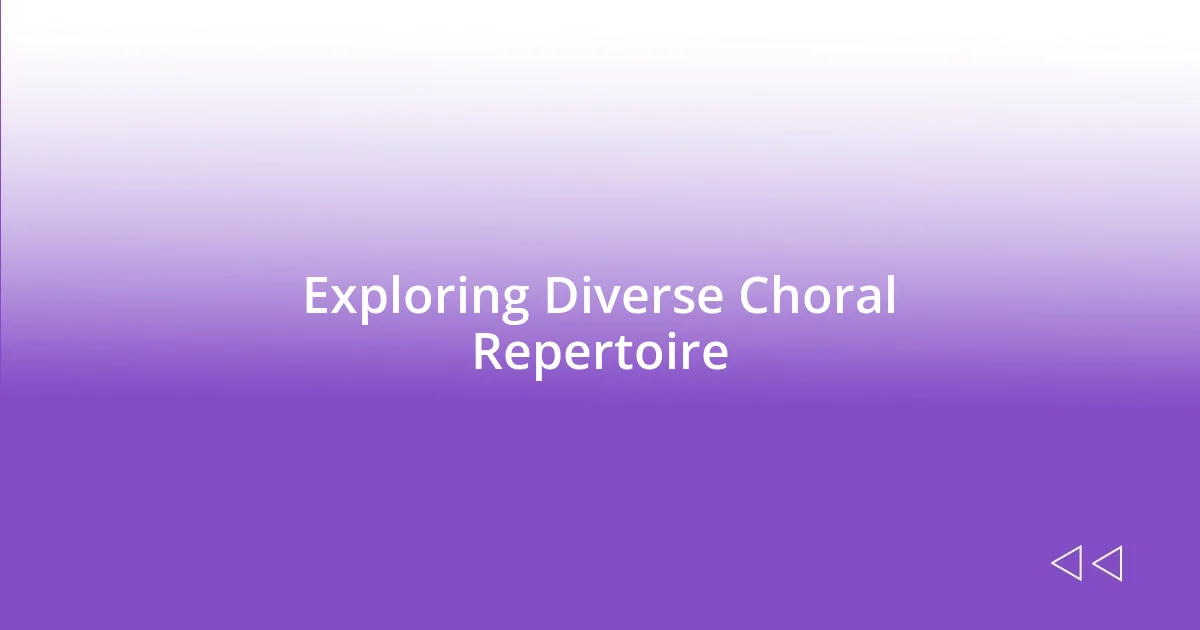Key takeaways:
- Engaging in choral music creates a profound sense of community and emotional connection, providing a shared human experience through harmony and collaboration.
- Choosing the right choir involves considering factors like repertoire, commitment level, and community atmosphere to enhance both musical enjoyment and social interactions.
- Incorporating diverse choral repertoire fosters creativity, emotional expression, and personal growth, transforming musicians into more versatile and empathetic individuals.

Discovering Choral Music Benefits
One of the most profound benefits I’ve experienced in engaging with choral music is the incredible sense of community it fosters. Singing in a group creates bonds that are hard to replicate elsewhere; it’s not just about hitting the right notes, but about creating something beautiful together. Have you ever felt the rush of harmony lift your spirits? It’s a reminder that we’re never alone in our voices.
I also find that choral music serves as a powerful emotional outlet. When I sing a piece that resonates with my feelings, it’s like releasing all the pent-up emotions inside me. I vividly remember performing a piece that spoke of loss and longing; the catharsis I felt while singing was transformative. Have you ever had a moment in music where you could feel your heartstrings being pulled? For me, that connection is a reaffirmation of our shared human experience.
Moreover, engaging with choral music provides cognitive benefits that are quite remarkable. Learning complex pieces can sharpen memory and improve concentration in ways I hadn’t expected. Each rehearsal feels like a workout for my brain, not just my voice. Isn’t it fascinating how something as melodious as music can enhance our mental agility? I often reflect on how enriching these experiences have been, both musically and intellectually.

Choosing the Right Choir
Choosing the right choir can significantly shape your choral experience. When I embarked on this journey, I discovered that each choir has its unique vibe and focus. For instance, I once joined a community choir that emphasized inclusivity and fun, which was refreshing. The shared laughter and excitement during rehearsals made me feel right at home.
When I was evaluating different options, I found it helpful to consider various factors:
- Repertoire: What type of music does the choir typically perform? This can influence your enjoyment and growth.
- Commitment Level: How often do they rehearse, and what is the expected time commitment?
- Performance Opportunities: Are there regular performances? This aspect can motivate you to refine your skills.
- Community Feel: Do the members seem welcoming and supportive? A friendly atmosphere can enhance your experience.
- Director’s Style: What’s the conductor like? Their approach can significantly affect your learning and enjoyment.
By reflecting on these elements, I found a choir that not only suited my musical interests but also enriched my social life. It’s incredible how the right choice can elevate your passion for choral music.

Techniques for Vocal Improvement
Improving vocal technique is a journey that can be rewarding and transformative. I have discovered that consistent practice of warm-up exercises not only prepares my voice but also helps me explore its full potential. Simple techniques like humming or lip trilling can really open up the vocal cords. Have you ever noticed how a few minutes of vocal exercises can dramatically affect your vocal range? In my experience, these warm-ups have made a tremendous difference in my singing ability, allowing me to tackle challenging pieces with confidence.
Notably, breath control is another critical aspect of vocal improvement. I learned early on that focusing on deep diaphragmatic breathing rather than shallow chest breathing helps support my voice. It’s fascinating how this technique can create a strong, resonant sound that fills the room. I vividly recall a performance where my ability to control my breath allowed me to sustain notes longer than I ever thought possible, giving me an exhilarating sense of power on stage.
Lastly, recording oneself while singing can be an eye-opening practice. Initially, I was hesitant to listen to my own voice, but doing so revealed nuances I wasn’t aware of before. I could pinpoint areas needing work, whether it was pitch accuracy or phrasing. This kind of feedback loop has become invaluable in my practice routine, leading to tangible improvement. Have you tried this technique? It can be a bit daunting, but I assure you it’s an impactful step towards better vocal mastery.
| Technique | Description |
|---|---|
| Warm-Up Exercises | Engaging in simple techniques like humming and lip trills to prepare the vocal cords. |
| Breath Control | Using diaphragmatic breathing to support vocal sound and sustain longer notes. |
| Self-Recording | Listening to recordings of oneself to identify strengths and improvement areas. |

Engaging in Rehearsal Practices
Engaging in choral rehearsals is more than just singing notes; it’s an experience that weaves together dedication, collaboration, and growth. I remember one rehearsal where the director asked us to focus not just on our individual parts, but to really hear how they intermingled. The moment I let go of my tendency to just sing my line and started listening to others, I felt a newfound sense of harmony and connection.
I often find that the energy in the rehearsal room can significantly influence how I engage with the music. During one particularly dynamic session, we spent an hour working through a tricky piece with cascading harmonies. Every time we nailed a section, the excitement pulsed through the room. It was infectious! Do you think that such moments can ignite a deeper passion for choral music? I truly believe they create lasting memories that push me to improve.
Another aspect I’ve noticed is the importance of feedback during rehearsals. At times, I’ve hesitated to speak up about a vocal concern, but eventually, I learned that sharing my questions not only helped me but also encouraged others to do the same. How impactful is it to create an environment where everyone feels comfortable discussing their struggles? In my experience, fostering that openness has made our rehearsals feel like a safe space for growth, allowing us to support one another as we strive for excellence together.

Performing in Choral Concerts
Performing in choral concerts brings a unique thrill that’s hard to replicate. I vividly remember the anticipation I felt backstage just moments before stepping into the spotlight. The air was electric, filled with whispered encouragement and nervous laughter. When we initially struck the first chords, it felt as if our voices were weaving a tapestry, rich and colorful, enveloping the audience in a collective experience. Isn’t it incredible how music has the power to turn a simple performance into such a vital connection?
I’ve also discovered that the little things often make the most significant difference in a concert setting. For example, I once participated in a concert under a stunning starry sky. As we sang a passionate piece, I couldn’t help but feel the serenity of the night mingling with our music. It wasn’t just about hitting the right notes; it was about touching hearts, including my own. Have you ever felt that wave of emotions where the audience’s response is a heartbeat that synchronizes with your singing? When moments like that happen, it reaffirms my love for choral music.
Moreover, the experience of performing isn’t just about showcasing our skills; it’s about vulnerability. The adrenaline rush comes with a mix of joy and fear. During one concert, I made a mistake mid-performance and felt a surge of panic. But, as the performance unfolded, I learned that the acceptance of imperfection can be liberating. In those moments, I realized how supportive our choir members were, and how resilience in the face of errors often creates a more genuine performance. Isn’t it fascinating how those small hiccups can lead to unforgettable memories? Every concert becomes a chapter in my journey, filled with laughter and valuable lessons.

Building Community through Choirs
Building community through choirs is a truly transformative experience. I once attended a small gathering after a rehearsal, where choir members shared personal stories over snacks. It felt like a revelation to realize that those harmonies we created on stage were underpinned by the friendships forming offstage. It made me wonder—how often do we find that connection outside of our musical endeavors?
One of my most cherished moments happened during a holiday concert where we invited the local community to join us. As we sang together, a wave of inclusivity washed over the room. It struck me how laughter, camaraderie, and music converged, creating a space where everyone felt welcomed and valued. Have you ever witnessed strangers connecting through a shared melody? It’s an exhilarating reminder that music truly knows no boundaries.
The power of a choir extends beyond just the notes; it fosters emotional support and inspires personal growth. I recall a choir member who was going through a tough time, and we rallied around them, dedicating a performance to their journey. Seeing their face light up made me realize how profoundly our bonds can uplift one another. Isn’t it magical how a shared passion can lead to such deep-seated relationships? Each rehearsal transforms into an opportunity to build our community, turning voices into a symphony of support.

Exploring Diverse Choral Repertoire
Exploring diverse choral repertoire opens up a world of musical expression that constantly excites me. I remember the first time my choir tackled a piece from a different culture—an African folk song filled with rhythmic energy and vibrant harmonies. The challenge of learning new vocal techniques made me realize how each piece carries its own story, allowing us to step into another person’s shoes, if only for a while. Have you ever felt that rush when a piece connects with your soul in a way you hadn’t expected?
Each time we delve into a different genre, it feels like peeling back layers to uncover hidden treasures. For instance, tackling a contemporary choral work was a game changer for me. The blend of traditional elements with modern expressions resonated deeply. I could feel the exhilaration in my voice as we explored unexpected dynamics and syncopation. It’s fascinating how this diversity in repertoire not only expands our musical abilities but also broadens our emotional horizons. Doesn’t it feel empowering to express a wide array of emotions through music?
Moreover, I’ve found that incorporating a variety of styles nurtures greater creativity within the choir. At one point, we dedicated a rehearsal to world music, experimenting with rhythms from around the globe. Surprisingly, I noticed how our cohesive sound became richer and more multifaceted. Each new genre encourages us to break out of our comfort zones, and the camaraderie that comes from tackling those challenges together is priceless. Isn’t it amazing how the journey through diverse choral repertoire can turn us into more versatile singers and, ultimately, more empathetic individuals?














